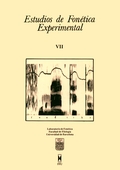Las ecuaciones del locus y el punto de articulación en español
Abstract
This paper explores the possibilities offered by locus equations for classifying stop consonants regarding place of articulation. Locus equations, originally conceived by Lindblom (1963), are linear functions obtained from a correlation between two F2 values of the postconsonantal vowel: F2 values at the first glottal pulse and the F2 values at the midvowel nucleus. An experiment with ten subjects (five male and five female), which produced a series of [p]-[b],' [t]-[d], [k]-[g] tokens for the 5 Spanish vowels, showed that, beyond individual and coarticulacion variation, each place is sharply identified by a locus equation. A later discriminant analysis confirmed this point: using either both slopes and y intercepts or slopes alone, a 100% correct classification followed. It seems thus that beyond the variation inherent to speech acts there are acoustic invariants explaining the communicative fact.
Downloads
Published
How to Cite
Issue
Section
License

This work is licensed under a Creative Commons Attribution-NonCommercial-NoDerivatives 4.0 International License.
All articles published online by Estudios de Fonética Experimental are licensed under Creative Commons Attribution-NonCommercial-NoDerivs 4.0 International (CC BY-NC-ND 4.0 DEED), unless otherwise noted. Estudios de Fonética Experimental is an open access journal. Estudios de Fonética Experimental is hosted by RCUB (Revistes Científiques de la Universitat de Barcelona), powered by Open Journal Systems (OJS) software. The copyright is not transferred to the journal: authors hold the copyright and publishing rights without restrictions. The author is free to use and distribute pre and post-prints versions of his/her article. However, preprint versions are regarded as a work-in-progress version used as internal communication with the authors, and we prefer to share postprint versions.




